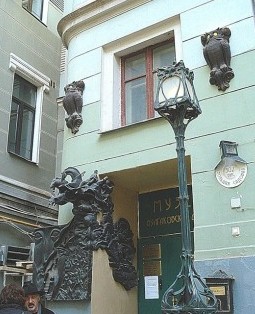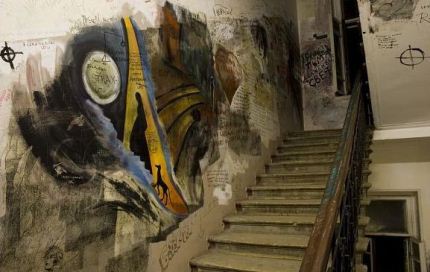

Bolshaya Sadovaya ulitsa 10, flat 52
Tel. (495) 970 0619
Subway: Mayakovskaya
Open: 1pm- 11pm Sun- Thu
1pm- 1am Fri- Sat

The Bulgakov Museum in Moscow is a writer's Museum dedicated to
the life and work of the author Mikhail Afanasyevich Bulgakov in an
apartment. Here he placed parts of his novel "the Master and
Margarita". Graffiti, including text from the novel and drawings of
its characters, decorated the exterior walls and stairwells of the
apartment building. It is located about two blocks from the
Patriarchal ponds, the opening scene of the novel's Chapter, where
the Moscow government planned to erect statues dedicated to the
novel. It is located near the Mayakovskaya metro station.
This luxury house was built by millionaire Ilya Pigit, owner of the
Dukat tobacco factory. It was adapted for the first workers '
commune after the revolution. In this house lived the dancer Isadora
Duncan and the poet Sergey Yesenin, Alice Koonen and Andrey Bely,
Vasily Surikov and bass Fyodor Chaliapin, futurists, members of the
art group "Jack of diamonds" and other representatives of the Moscow
Bohemians. Later they were replaced by the Moscow proletariat in the
first post-revolutionary years. The studios of artists Pyotr
Konchalovsky and Georgy Yakulov, which were located in the courtyard
of house 10, were miraculously preserved.
Communal apartment
No. 50, where Mikhail Bulgakov and his wife lived in 1921-1924,
became the prototype of this Bad apartment, where Woland settled
with his entourage. Years passed, and the staircase of entrance No.
6 received the glory of an enchanted place. Since the 70s, people
have come here to sit on these steps, remember their favorite
fragments from the novel, sing and discuss one of the most famous
Russian novels. The staircase became one of the unofficial cultural
centers of Moscow in the 1980s and 90s. A "hippie Academy" was
organized in the attic, and the entrance walls were covered with
drawings, quotes from Bulgakov's works, and declarations of love for
Bulgakov and his characters. Over the years, the door of apartment
No. 50 was closed to Bulgakov's fans: it housed the design Bureau.
But in the 1990s, the Bulgakov Foundation was based there, and since
April 2007, it has been the only official Bulgakov Museum in Russia.
The building was built between 1902 and 1905 as an
apartment building commissioned by the Russian millionaire Ilya
Pigit, owner of the Dukat tobacco factory. The building is designed
in the Russian version of the Art Nouveau style. At that time,
construction in Moscow was flourishing, just then the Garden ring
was being built around the center of Moscow, consisting of wide
streets lined with trees. Bolshaya Sadovaya street was also a part
of it. In June 1917, on the eve of the October revolution, Ilya
Pigit sold the building to a private real estate company. The sale
was a good move, because after the revolution, the new Soviet
government demanded to turn the house into one of the first
buildings for communal apartments in Moscow. In 1938, the building
lost much of its original charm after the front fence was removed to
widen the street.
In September 1921, Soviet writer Mikhail
Bulgakov moved into apartment number 50 on the first floor with his
wife Tatyana Nikolaevna Lappa. Bulgakov was an ardent opponent of
the Soviet government and once expressed his hatred of communal
apartments, in particular, apartment number 50 on Bolshaya Sadovaya
street, 10, as follows
“
" on Bolshaya Sadovaya
There is a
healthy house.
Our brother lives in the house
Organized
proletariat.."
Bulgakov made the building one of the most
significant places in his famous novel the Master and Margarita, it
is there that the "Bad apartment"is located.
In the novel
Master and Margarita, Bulgakov did not assign the building number 10
– its real number, but used the number 302 bis-with a certain hint
of the intricate bureaucratic system of the Soviet system at that
time.
In the summer of 1924, Bulgakov, having dealt with his
Affairs, was able to move to the 5th floor, to a quieter apartment
at number 34, some of the characteristics of which, by the way, he
also used to describe apartment 50 in his novel. Tatiana Lappa, his
wife, later realized that Bulgakov had organized this move only so
that she would not be left alone in an unpleasant situation for her,
because a few months later Bulgakov himself left the building
altogether to move in with Lyubov Evgenievna Belozerskaya, whom he
married in April 1925.
In one of the apartments at No. 10
Bolshaya Sadovaya street, Sergei Yesenin met the American dancer
Isadora Duncan, who later became his wife
The Grand opening of the cultural and educational
center "Bulgakov's House" took place on may 15, 2004.
The
opening of the center was attended by more than five hundred people,
including famous cultural figures, Bulgakov scholars, actors of
Moscow theaters, artists, intellectuals and fans of the writer's
work. The event was widely covered in the media: film crews of the
TV channels "Culture", "TVC" and "RTR. Vesti-Stolitsa, as well as
correspondents of Central print publications such as Izvestia,
Vedomosti, Kommersant, and others.
When my friends and
associates and I decided to organize a Bulgakov Museum, the "bad
apartment" was closed, and an official announcement hung on the
entrance door that there was no Museum here and could not be. People
who came to the courtyard of the famous house on Sadovaya street
left with nothing. Then we thought: if the state doesn't care about
the Bulgakov Museum, and we care, why don't we create it ourselves.
We found fans of the writer's work on the Internet, went to the
Phoenix society, which for 20 years has been collecting information
on Bulgakov and organizing meetings of Bulgakov scholars, called
collectors and found the first items for the Museum exhibition. We
decided to open on the writer's birthday, and on may 15, 2004, the
Bulgakov house Cultural and educational center began its
work-Nikolai Borisovich Golubev, the founder of the cultural and
educational center.